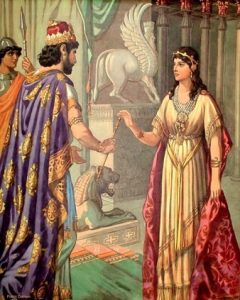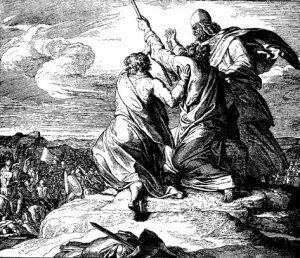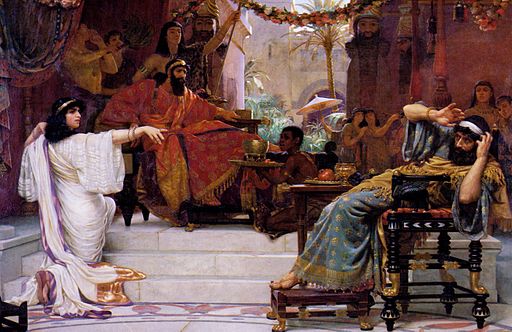by Lois Tverberg
The feast of Purim is the annual celebration of the salvation of the Jews from destruction that is described in the book of Esther. It is the story of how Esther and her uncle Mordecai saved the Jewish people in about 500 BC in Persia.
 In the story, an advisor to the king, Haman, was angered by the fact that Mordecai would not bow down to him, so he convinced the king to issue an edict calling for the destruction of the entire Jewish people. Esther saved the Jews by risking her life to plead to the king to annul the edict, and by exposing Haman’s plot against them.
In the story, an advisor to the king, Haman, was angered by the fact that Mordecai would not bow down to him, so he convinced the king to issue an edict calling for the destruction of the entire Jewish people. Esther saved the Jews by risking her life to plead to the king to annul the edict, and by exposing Haman’s plot against them.
Interestingly, the name of God is never mentioned in the story, although his hand is clearly present in every event. A tradition that celebrates this is to dress up in costumes and masks on Purim, to celebrate that sometimes even God wears a “mask” — that he is present even when he doesn’t seem to be. The feast is often celebrated with silly plays (shpiels) based on the story of Esther, and is lighthearted to celebrate God’s care for his people even when he doesn’t seem to be present.
The Longer Epic of this Story
The story of Esther is actually the culmination of a much longer saga that stretches over 1300 years in the life of Israel. A key to the story is the identity of Haman, who is described as an “Agagite.”
Agag was the king of the Amalekites in Saul’s time, so Haman is an Amalekite. While we hear about so many “ite” groups in the Old Testament that they all seem to be the same, the Amalekites have the distinction of being thought of by Jews as Israel’s worst enemy of all time.
 The Amalekites were the first nation that ever attacked Israel, and they did this almost immediately after Israel had left Egypt, when they first entered the wilderness (Exodus 17). Being the first to attack, they became symbolic of all of the nations that want to destroy Israel.
The Amalekites were the first nation that ever attacked Israel, and they did this almost immediately after Israel had left Egypt, when they first entered the wilderness (Exodus 17). Being the first to attack, they became symbolic of all of the nations that want to destroy Israel.
The Amalekites also chose a particularly cowardly and brutal way to attack, by coming from the rear and killing the elderly and weaker Israelites that were straggling behind. As a result, God was furious with the Amalekites, and singled them out for divine judgment:
Then the LORD said to Moses, “Write this in a book as a memorial and recite it to Joshua, that I will utterly blot out the memory of Amalek from under heaven.” Moses built an altar and named it The LORD is My Banner; and he said, “The LORD has sworn; the LORD will have war against Amalek from generation to generation.” (Ex. 17:14-16)
The words seem contradictory — that God will be continually at war with Amalek, and yet he will blot them out. How can both be true? But oddly they are. The Amalekites continually plagued the Israelites throughout their history. When Israel first tried to enter the promised land but lost faith in God, the Amalekites were there to attack them.
Later, Saul was given the command to destroy them and leave nothing alive, even children or animals (1 Sam. 15:7-9). He instead disobeyed God and kept some of the best animals for himself, and let King Agag live.
According to Jewish thought, a demonic hatred of Israel was associated with that nation, and by taking any booty that was contaminated by that spirit, or letting anything of theirs escape, Saul allowed this spirit of destruction to come back to terrorize Israel again. King David and King Hezekiah also fought against them during their reigns, and they were back again during the time of Esther.
In the story of Esther there are several motifs hinting that the Amalekites are back to try once again to destroy Israel. Often when the text speaks of Haman as an enemy of the Jews, it specifically emphasizes his nationality as an “Agagite,” a descent of the Amalekite king:
Then the king took his signet ring from his hand and gave it to Haman, the son of Hammedatha the Agagite, the enemy of the Jews. (Esth. 3:10)
For Haman the son of Hammedatha, the Agagite, the adversary of all the Jews, had schemed against the Jews to destroy them and had cast Pur, that is the lot, to disturb them and destroy them. (Esth. 9:24)
There are more parallels between this story and that of Saul that hint that this is the completion of Saul’s unfinished work. The narrator is explicit in showing that Mordecai and Esther are from the family of Saul, fellow Benjaminites and descendants of his line (Esth. 2:5-6).
While Saul kept some of the booty for himself, the story of Esther points out repeatedly that the Jews took none of the plunder after they were allowed to kill Haman and his descendants. By not committing Saul’s sin, they finally had victory.
Help for Hard Passages
This story has helped me understand some of the difficult commands of God. God had said to Saul,
Now go and strike Amalek and utterly destroy all that he has, and do not spare him; but put to death both man and woman, child and infant, ox and sheep, camel and donkey. (1 Sam. 15:3)
After Saul disobeyed God, not through showing mercy to the people, but instead by keeping some of the best livestock for himself, God said that he had regretted making Saul king, and decided to remove him from the throne.
It shocks us that God could give such a horrible command and be so angry to see it not carried out. God’s harsh command to Saul to destroy every living thing of the Amalekites was because this was a nation bent on the destruction of Israel, without whom the world would have no Savior. Israel was nearly annihilated in Esther’s time because of Saul’s disobedience. Sometimes God’s commands are incomprehensible, but if we had his perspective, we would see his logic.
The Epic Goes On
Interestingly, in Jewish thought, even though the Amalekites are no more, the demonic spirit of Amalek has lived from ancient times even until today. The forefather of the nation, Amalek, was Esau’s grandson. According to legend, when Esau was old, he said to his grandson Amalek: “I tried to kill Jacob but was unable. Now I am entrusting you and your descendents with the mission of annihilating Jacob’s descendents — the Jewish people. Carry out this deed for me. Be relentless and do not show mercy.” (This isn’t biblical, but it shows their attitude toward the Amalekites.)
Throughout history, there has been relentless anti-Semitism, persecution and attempts by other nations to annihilate the Jewish people. Hitler was considered to be a spiritual “descendant” of Haman. God has been continually at war with the spirit of Amalek from generation to generation, and only in the final judgment will this spirit of hatred be blotted out.
~~~~
(1) Alfred Edersheim, Bible History: Old Testament, 1890. Chapter 9, available at this link.
(2) JPS Torah Commentary on Deuteronomy, by Jeffrey Tigay. Jewish Publication Society, 1996, p 236.
(3) E. E. Halevy, Amalekites, Encyclopedia Judaica CD-ROM, Version 1.0, 1997
Photos: Otto Semler [Public Domain], Julius Schnorr von Carolsfeld [Public domain], Ernest Normand [Public domain]


